Air NZ Resource Integration Management Practices: A Detailed Report
VerifiedAdded on 2023/04/08
|30
|7957
|265
Report
AI Summary
This report provides a comprehensive analysis of Air New Zealand's resource integration management practices. It begins by defining integrated resource management and its importance in minimizing operational risks, particularly within the aviation industry. The report delves into Air NZ's specific resource integration practices, underpinned by theories such as effectuation and configuration, highlighting the importance of collaboration and efficient resource utilization. A review of operational problems, including passenger load and capacity issues, is presented alongside a VRIO analysis to assess Air NZ's competitive advantages. The study further examines the organization's internal processes, focusing on human resources, tangible assets, and intangible assets, as well as external factors through a PESTEL analysis. Key strategic concepts guiding resource integration, such as Total Quality Management and Lean Production systems, are identified and critically analyzed. The impact of strategic responses on Air NZ's operational objectives is evaluated, and a practical process for improving resource integration practices is developed. Finally, the report addresses the range of operational and financial risks and concludes with a cost-benefit analysis of the proposed improvements.
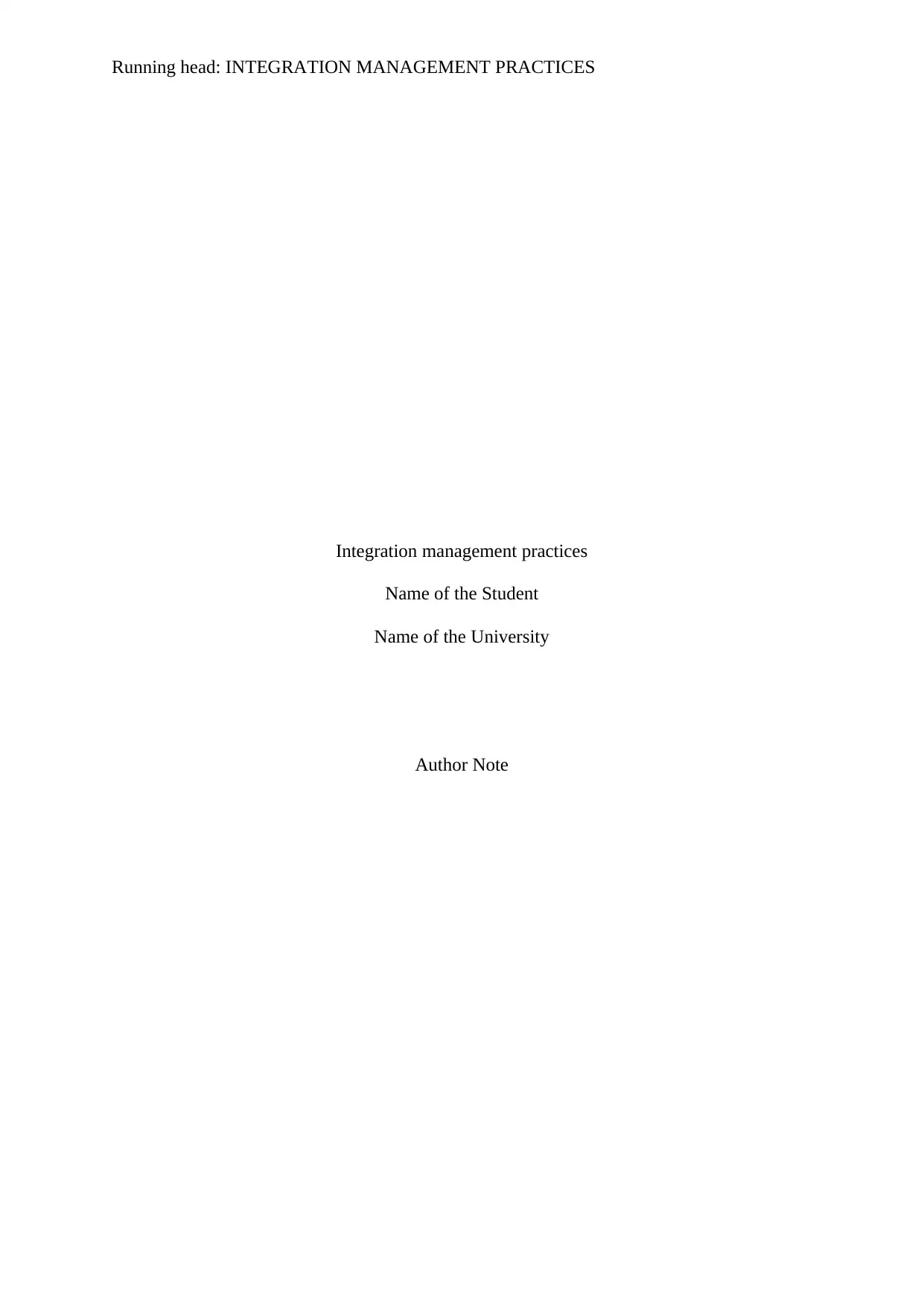
Running head: INTEGRATION MANAGEMENT PRACTICES
Integration management practices
Name of the Student
Name of the University
Author Note
Integration management practices
Name of the Student
Name of the University
Author Note
Paraphrase This Document
Need a fresh take? Get an instant paraphrase of this document with our AI Paraphraser
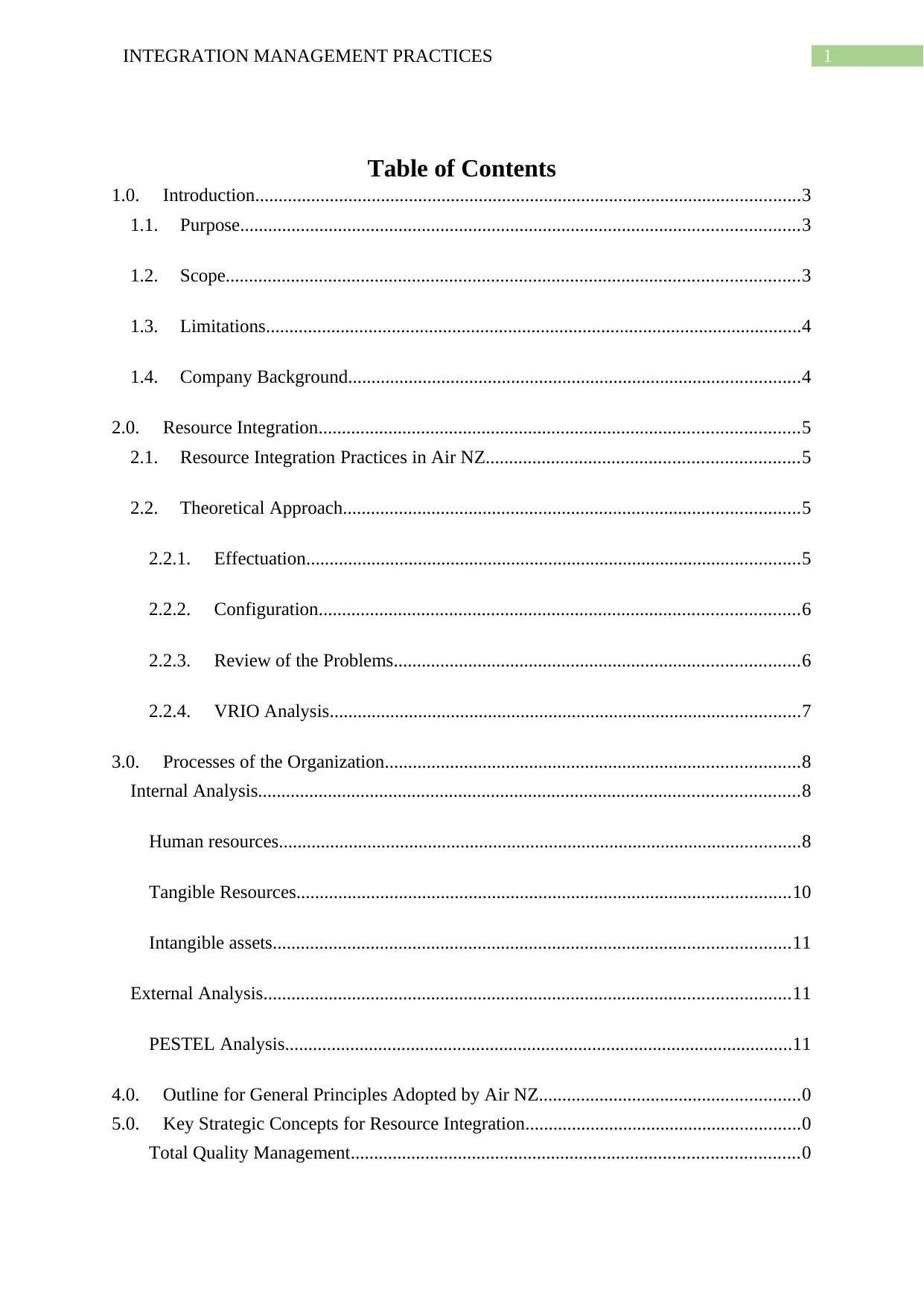
1INTEGRATION MANAGEMENT PRACTICES
Table of Contents
1.0. Introduction.....................................................................................................................3
1.1. Purpose........................................................................................................................3
1.2. Scope...........................................................................................................................3
1.3. Limitations...................................................................................................................4
1.4. Company Background.................................................................................................4
2.0. Resource Integration.......................................................................................................5
2.1. Resource Integration Practices in Air NZ...................................................................5
2.2. Theoretical Approach..................................................................................................5
2.2.1. Effectuation..........................................................................................................5
2.2.2. Configuration.......................................................................................................6
2.2.3. Review of the Problems.......................................................................................6
2.2.4. VRIO Analysis.....................................................................................................7
3.0. Processes of the Organization.........................................................................................8
Internal Analysis....................................................................................................................8
Human resources................................................................................................................8
Tangible Resources..........................................................................................................10
Intangible assets...............................................................................................................11
External Analysis.................................................................................................................11
PESTEL Analysis.............................................................................................................11
4.0. Outline for General Principles Adopted by Air NZ........................................................0
5.0. Key Strategic Concepts for Resource Integration...........................................................0
Total Quality Management................................................................................................0
Table of Contents
1.0. Introduction.....................................................................................................................3
1.1. Purpose........................................................................................................................3
1.2. Scope...........................................................................................................................3
1.3. Limitations...................................................................................................................4
1.4. Company Background.................................................................................................4
2.0. Resource Integration.......................................................................................................5
2.1. Resource Integration Practices in Air NZ...................................................................5
2.2. Theoretical Approach..................................................................................................5
2.2.1. Effectuation..........................................................................................................5
2.2.2. Configuration.......................................................................................................6
2.2.3. Review of the Problems.......................................................................................6
2.2.4. VRIO Analysis.....................................................................................................7
3.0. Processes of the Organization.........................................................................................8
Internal Analysis....................................................................................................................8
Human resources................................................................................................................8
Tangible Resources..........................................................................................................10
Intangible assets...............................................................................................................11
External Analysis.................................................................................................................11
PESTEL Analysis.............................................................................................................11
4.0. Outline for General Principles Adopted by Air NZ........................................................0
5.0. Key Strategic Concepts for Resource Integration...........................................................0
Total Quality Management................................................................................................0
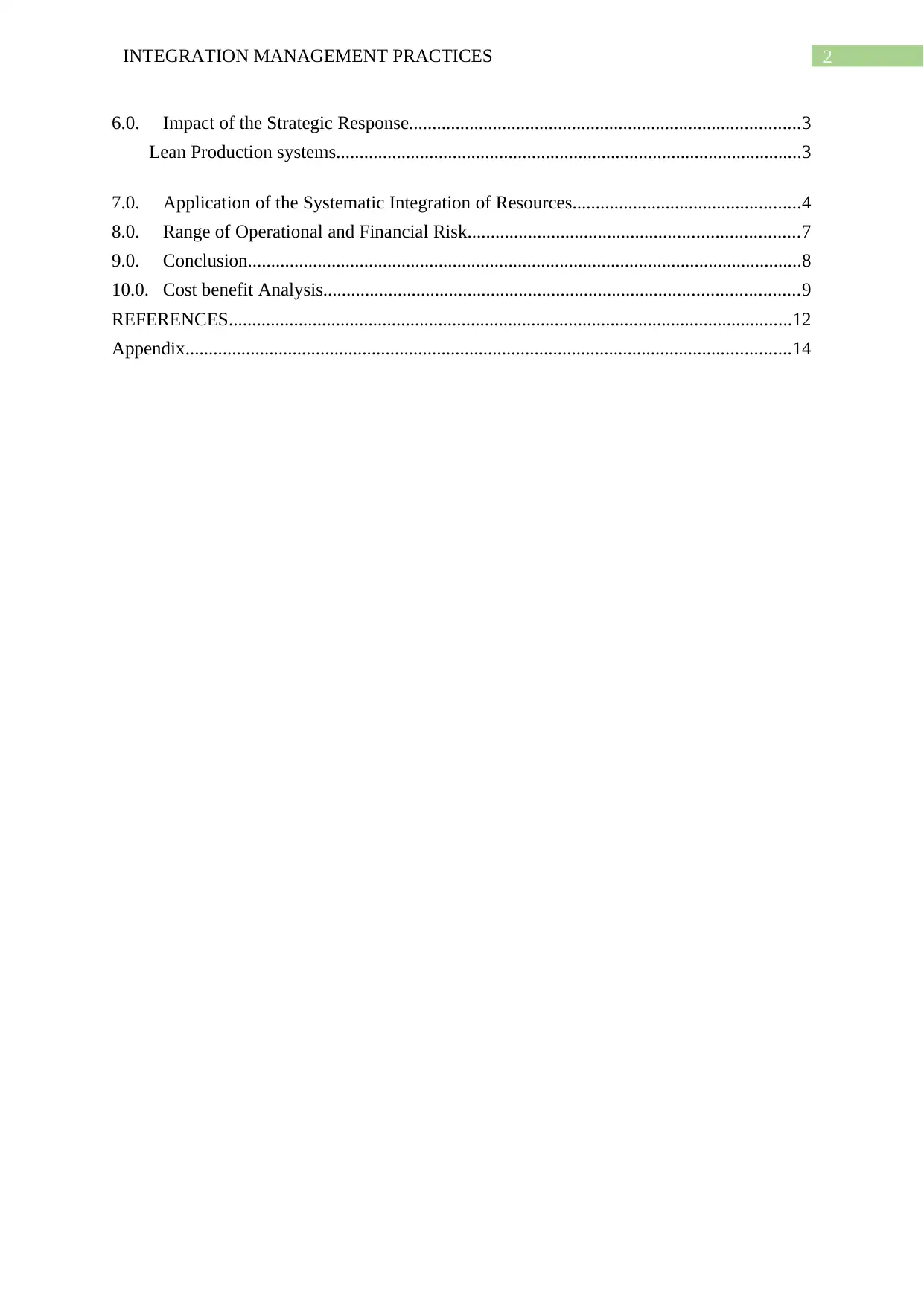
2INTEGRATION MANAGEMENT PRACTICES
6.0. Impact of the Strategic Response....................................................................................3
Lean Production systems....................................................................................................3
7.0. Application of the Systematic Integration of Resources.................................................4
8.0. Range of Operational and Financial Risk.......................................................................7
9.0. Conclusion.......................................................................................................................8
10.0. Cost benefit Analysis......................................................................................................9
REFERENCES.........................................................................................................................12
Appendix..................................................................................................................................14
6.0. Impact of the Strategic Response....................................................................................3
Lean Production systems....................................................................................................3
7.0. Application of the Systematic Integration of Resources.................................................4
8.0. Range of Operational and Financial Risk.......................................................................7
9.0. Conclusion.......................................................................................................................8
10.0. Cost benefit Analysis......................................................................................................9
REFERENCES.........................................................................................................................12
Appendix..................................................................................................................................14
⊘ This is a preview!⊘
Do you want full access?
Subscribe today to unlock all pages.

Trusted by 1+ million students worldwide
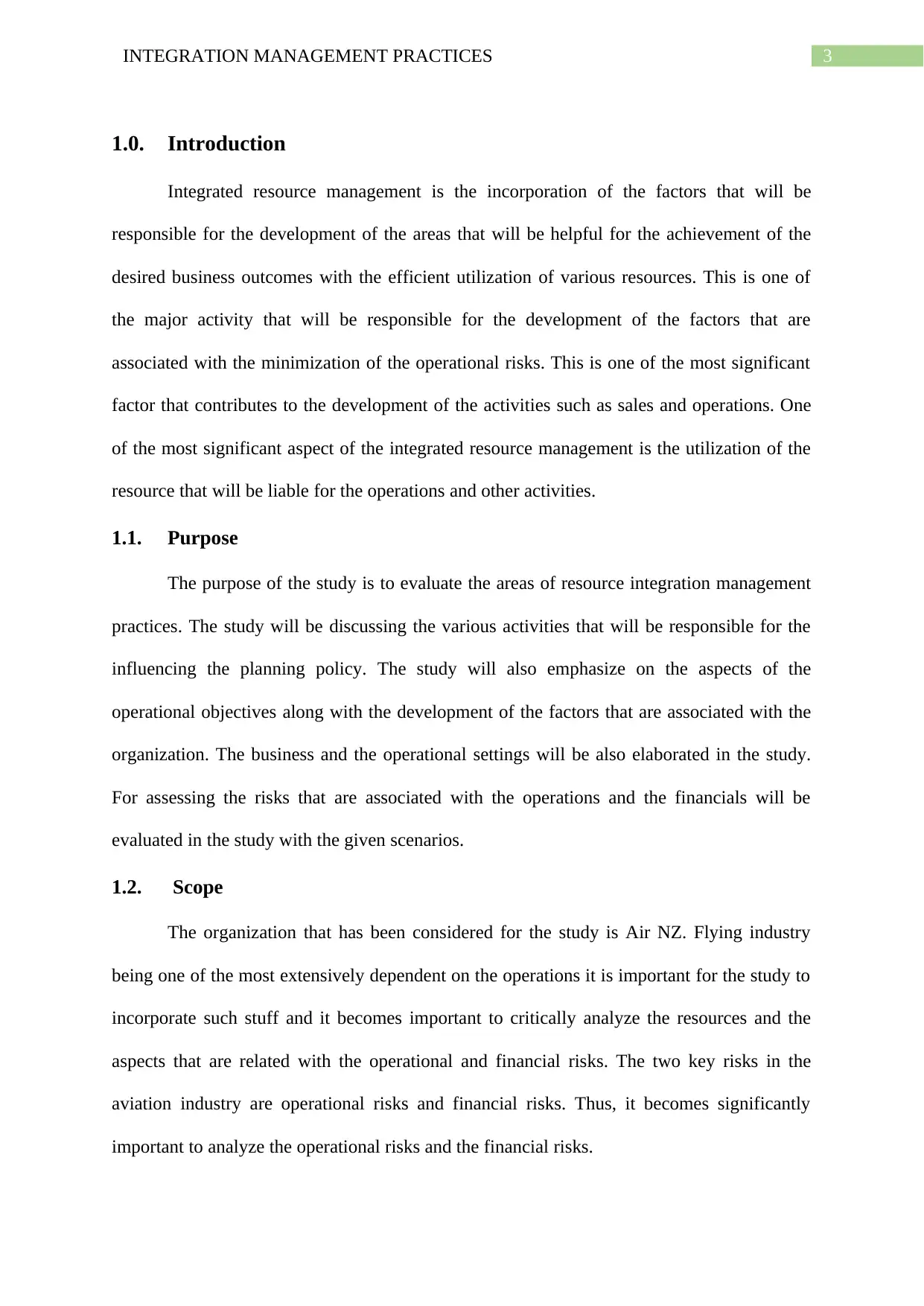
3INTEGRATION MANAGEMENT PRACTICES
1.0. Introduction
Integrated resource management is the incorporation of the factors that will be
responsible for the development of the areas that will be helpful for the achievement of the
desired business outcomes with the efficient utilization of various resources. This is one of
the major activity that will be responsible for the development of the factors that are
associated with the minimization of the operational risks. This is one of the most significant
factor that contributes to the development of the activities such as sales and operations. One
of the most significant aspect of the integrated resource management is the utilization of the
resource that will be liable for the operations and other activities.
1.1. Purpose
The purpose of the study is to evaluate the areas of resource integration management
practices. The study will be discussing the various activities that will be responsible for the
influencing the planning policy. The study will also emphasize on the aspects of the
operational objectives along with the development of the factors that are associated with the
organization. The business and the operational settings will be also elaborated in the study.
For assessing the risks that are associated with the operations and the financials will be
evaluated in the study with the given scenarios.
1.2. Scope
The organization that has been considered for the study is Air NZ. Flying industry
being one of the most extensively dependent on the operations it is important for the study to
incorporate such stuff and it becomes important to critically analyze the resources and the
aspects that are related with the operational and financial risks. The two key risks in the
aviation industry are operational risks and financial risks. Thus, it becomes significantly
important to analyze the operational risks and the financial risks.
1.0. Introduction
Integrated resource management is the incorporation of the factors that will be
responsible for the development of the areas that will be helpful for the achievement of the
desired business outcomes with the efficient utilization of various resources. This is one of
the major activity that will be responsible for the development of the factors that are
associated with the minimization of the operational risks. This is one of the most significant
factor that contributes to the development of the activities such as sales and operations. One
of the most significant aspect of the integrated resource management is the utilization of the
resource that will be liable for the operations and other activities.
1.1. Purpose
The purpose of the study is to evaluate the areas of resource integration management
practices. The study will be discussing the various activities that will be responsible for the
influencing the planning policy. The study will also emphasize on the aspects of the
operational objectives along with the development of the factors that are associated with the
organization. The business and the operational settings will be also elaborated in the study.
For assessing the risks that are associated with the operations and the financials will be
evaluated in the study with the given scenarios.
1.2. Scope
The organization that has been considered for the study is Air NZ. Flying industry
being one of the most extensively dependent on the operations it is important for the study to
incorporate such stuff and it becomes important to critically analyze the resources and the
aspects that are related with the operational and financial risks. The two key risks in the
aviation industry are operational risks and financial risks. Thus, it becomes significantly
important to analyze the operational risks and the financial risks.
Paraphrase This Document
Need a fresh take? Get an instant paraphrase of this document with our AI Paraphraser
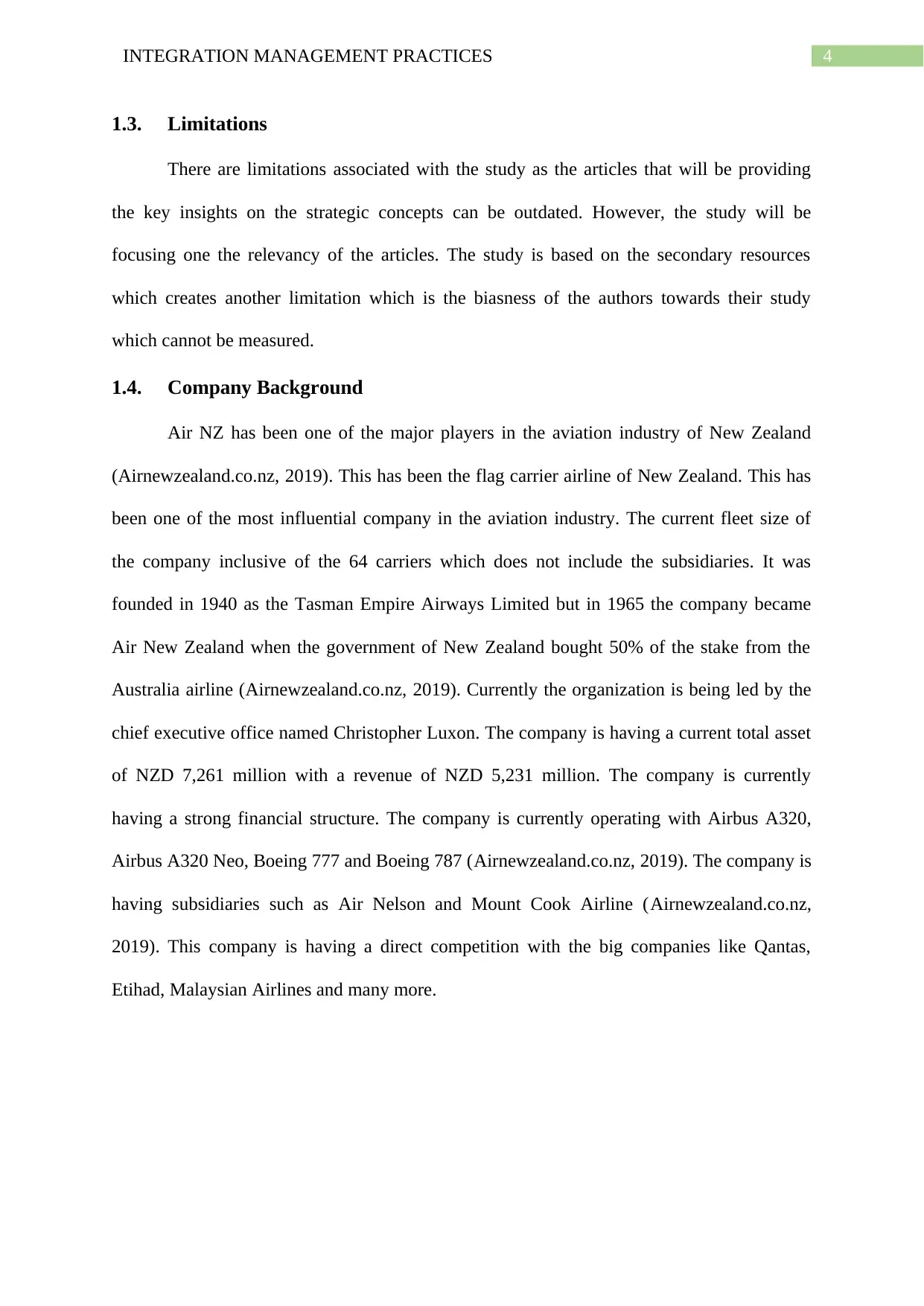
4INTEGRATION MANAGEMENT PRACTICES
1.3. Limitations
There are limitations associated with the study as the articles that will be providing
the key insights on the strategic concepts can be outdated. However, the study will be
focusing one the relevancy of the articles. The study is based on the secondary resources
which creates another limitation which is the biasness of the authors towards their study
which cannot be measured.
1.4. Company Background
Air NZ has been one of the major players in the aviation industry of New Zealand
(Airnewzealand.co.nz, 2019). This has been the flag carrier airline of New Zealand. This has
been one of the most influential company in the aviation industry. The current fleet size of
the company inclusive of the 64 carriers which does not include the subsidiaries. It was
founded in 1940 as the Tasman Empire Airways Limited but in 1965 the company became
Air New Zealand when the government of New Zealand bought 50% of the stake from the
Australia airline (Airnewzealand.co.nz, 2019). Currently the organization is being led by the
chief executive office named Christopher Luxon. The company is having a current total asset
of NZD 7,261 million with a revenue of NZD 5,231 million. The company is currently
having a strong financial structure. The company is currently operating with Airbus A320,
Airbus A320 Neo, Boeing 777 and Boeing 787 (Airnewzealand.co.nz, 2019). The company is
having subsidiaries such as Air Nelson and Mount Cook Airline (Airnewzealand.co.nz,
2019). This company is having a direct competition with the big companies like Qantas,
Etihad, Malaysian Airlines and many more.
1.3. Limitations
There are limitations associated with the study as the articles that will be providing
the key insights on the strategic concepts can be outdated. However, the study will be
focusing one the relevancy of the articles. The study is based on the secondary resources
which creates another limitation which is the biasness of the authors towards their study
which cannot be measured.
1.4. Company Background
Air NZ has been one of the major players in the aviation industry of New Zealand
(Airnewzealand.co.nz, 2019). This has been the flag carrier airline of New Zealand. This has
been one of the most influential company in the aviation industry. The current fleet size of
the company inclusive of the 64 carriers which does not include the subsidiaries. It was
founded in 1940 as the Tasman Empire Airways Limited but in 1965 the company became
Air New Zealand when the government of New Zealand bought 50% of the stake from the
Australia airline (Airnewzealand.co.nz, 2019). Currently the organization is being led by the
chief executive office named Christopher Luxon. The company is having a current total asset
of NZD 7,261 million with a revenue of NZD 5,231 million. The company is currently
having a strong financial structure. The company is currently operating with Airbus A320,
Airbus A320 Neo, Boeing 777 and Boeing 787 (Airnewzealand.co.nz, 2019). The company is
having subsidiaries such as Air Nelson and Mount Cook Airline (Airnewzealand.co.nz,
2019). This company is having a direct competition with the big companies like Qantas,
Etihad, Malaysian Airlines and many more.
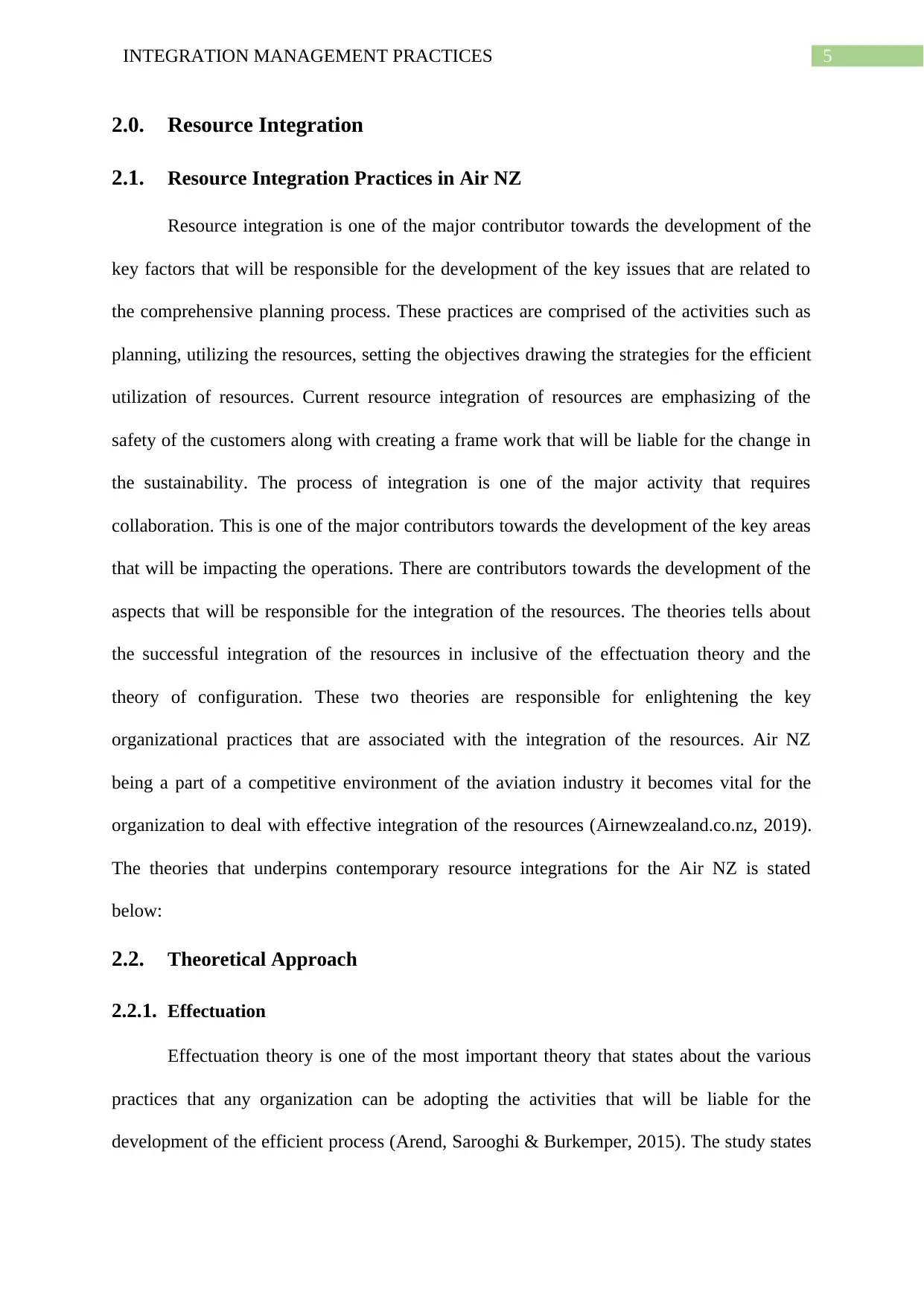
5INTEGRATION MANAGEMENT PRACTICES
2.0. Resource Integration
2.1. Resource Integration Practices in Air NZ
Resource integration is one of the major contributor towards the development of the
key factors that will be responsible for the development of the key issues that are related to
the comprehensive planning process. These practices are comprised of the activities such as
planning, utilizing the resources, setting the objectives drawing the strategies for the efficient
utilization of resources. Current resource integration of resources are emphasizing of the
safety of the customers along with creating a frame work that will be liable for the change in
the sustainability. The process of integration is one of the major activity that requires
collaboration. This is one of the major contributors towards the development of the key areas
that will be impacting the operations. There are contributors towards the development of the
aspects that will be responsible for the integration of the resources. The theories tells about
the successful integration of the resources in inclusive of the effectuation theory and the
theory of configuration. These two theories are responsible for enlightening the key
organizational practices that are associated with the integration of the resources. Air NZ
being a part of a competitive environment of the aviation industry it becomes vital for the
organization to deal with effective integration of the resources (Airnewzealand.co.nz, 2019).
The theories that underpins contemporary resource integrations for the Air NZ is stated
below:
2.2. Theoretical Approach
2.2.1. Effectuation
Effectuation theory is one of the most important theory that states about the various
practices that any organization can be adopting the activities that will be liable for the
development of the efficient process (Arend, Sarooghi & Burkemper, 2015). The study states
2.0. Resource Integration
2.1. Resource Integration Practices in Air NZ
Resource integration is one of the major contributor towards the development of the
key factors that will be responsible for the development of the key issues that are related to
the comprehensive planning process. These practices are comprised of the activities such as
planning, utilizing the resources, setting the objectives drawing the strategies for the efficient
utilization of resources. Current resource integration of resources are emphasizing of the
safety of the customers along with creating a frame work that will be liable for the change in
the sustainability. The process of integration is one of the major activity that requires
collaboration. This is one of the major contributors towards the development of the key areas
that will be impacting the operations. There are contributors towards the development of the
aspects that will be responsible for the integration of the resources. The theories tells about
the successful integration of the resources in inclusive of the effectuation theory and the
theory of configuration. These two theories are responsible for enlightening the key
organizational practices that are associated with the integration of the resources. Air NZ
being a part of a competitive environment of the aviation industry it becomes vital for the
organization to deal with effective integration of the resources (Airnewzealand.co.nz, 2019).
The theories that underpins contemporary resource integrations for the Air NZ is stated
below:
2.2. Theoretical Approach
2.2.1. Effectuation
Effectuation theory is one of the most important theory that states about the various
practices that any organization can be adopting the activities that will be liable for the
development of the efficient process (Arend, Sarooghi & Burkemper, 2015). The study states
⊘ This is a preview!⊘
Do you want full access?
Subscribe today to unlock all pages.

Trusted by 1+ million students worldwide
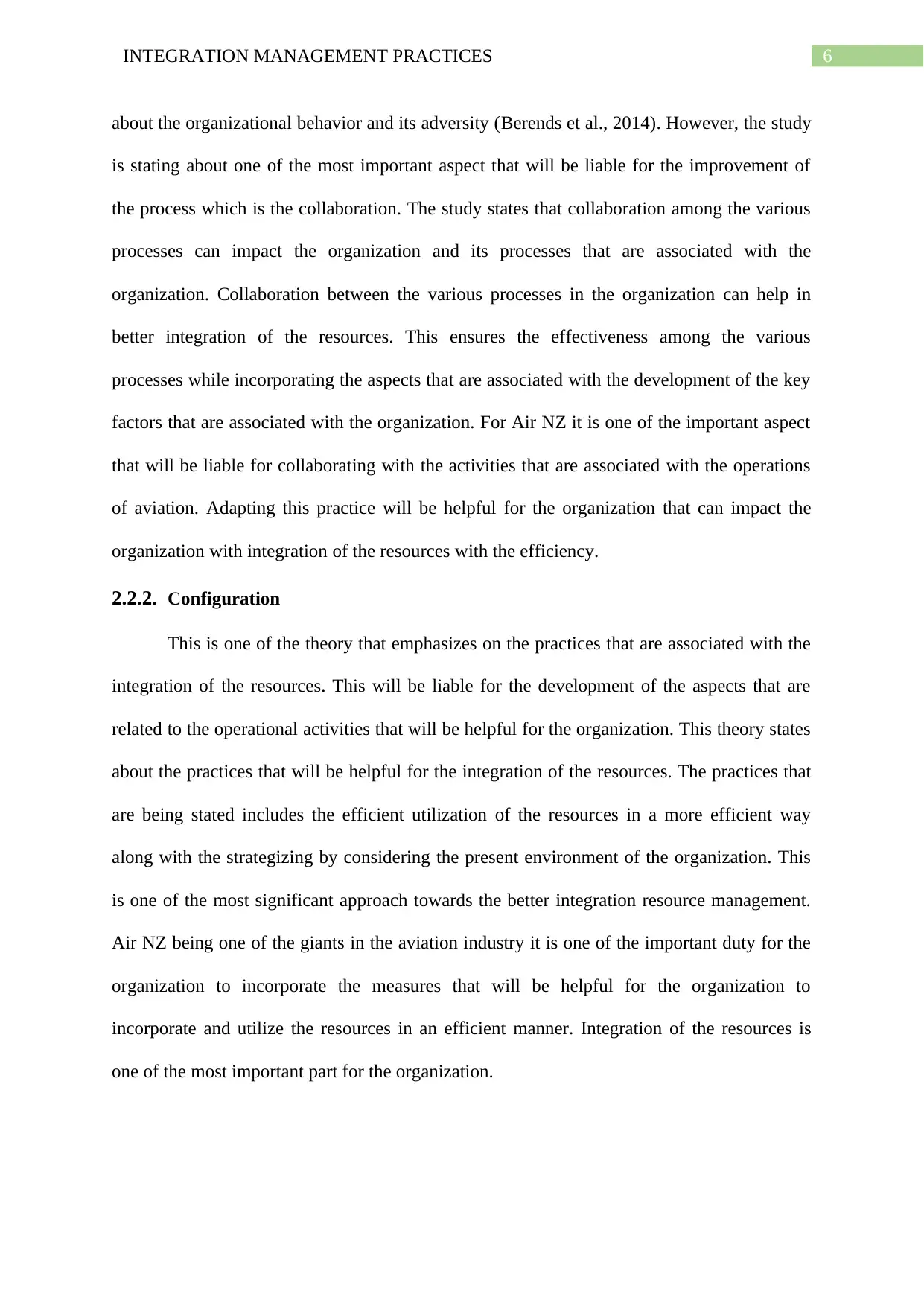
6INTEGRATION MANAGEMENT PRACTICES
about the organizational behavior and its adversity (Berends et al., 2014). However, the study
is stating about one of the most important aspect that will be liable for the improvement of
the process which is the collaboration. The study states that collaboration among the various
processes can impact the organization and its processes that are associated with the
organization. Collaboration between the various processes in the organization can help in
better integration of the resources. This ensures the effectiveness among the various
processes while incorporating the aspects that are associated with the development of the key
factors that are associated with the organization. For Air NZ it is one of the important aspect
that will be liable for collaborating with the activities that are associated with the operations
of aviation. Adapting this practice will be helpful for the organization that can impact the
organization with integration of the resources with the efficiency.
2.2.2. Configuration
This is one of the theory that emphasizes on the practices that are associated with the
integration of the resources. This will be liable for the development of the aspects that are
related to the operational activities that will be helpful for the organization. This theory states
about the practices that will be helpful for the integration of the resources. The practices that
are being stated includes the efficient utilization of the resources in a more efficient way
along with the strategizing by considering the present environment of the organization. This
is one of the most significant approach towards the better integration resource management.
Air NZ being one of the giants in the aviation industry it is one of the important duty for the
organization to incorporate the measures that will be helpful for the organization to
incorporate and utilize the resources in an efficient manner. Integration of the resources is
one of the most important part for the organization.
about the organizational behavior and its adversity (Berends et al., 2014). However, the study
is stating about one of the most important aspect that will be liable for the improvement of
the process which is the collaboration. The study states that collaboration among the various
processes can impact the organization and its processes that are associated with the
organization. Collaboration between the various processes in the organization can help in
better integration of the resources. This ensures the effectiveness among the various
processes while incorporating the aspects that are associated with the development of the key
factors that are associated with the organization. For Air NZ it is one of the important aspect
that will be liable for collaborating with the activities that are associated with the operations
of aviation. Adapting this practice will be helpful for the organization that can impact the
organization with integration of the resources with the efficiency.
2.2.2. Configuration
This is one of the theory that emphasizes on the practices that are associated with the
integration of the resources. This will be liable for the development of the aspects that are
related to the operational activities that will be helpful for the organization. This theory states
about the practices that will be helpful for the integration of the resources. The practices that
are being stated includes the efficient utilization of the resources in a more efficient way
along with the strategizing by considering the present environment of the organization. This
is one of the most significant approach towards the better integration resource management.
Air NZ being one of the giants in the aviation industry it is one of the important duty for the
organization to incorporate the measures that will be helpful for the organization to
incorporate and utilize the resources in an efficient manner. Integration of the resources is
one of the most important part for the organization.
Paraphrase This Document
Need a fresh take? Get an instant paraphrase of this document with our AI Paraphraser
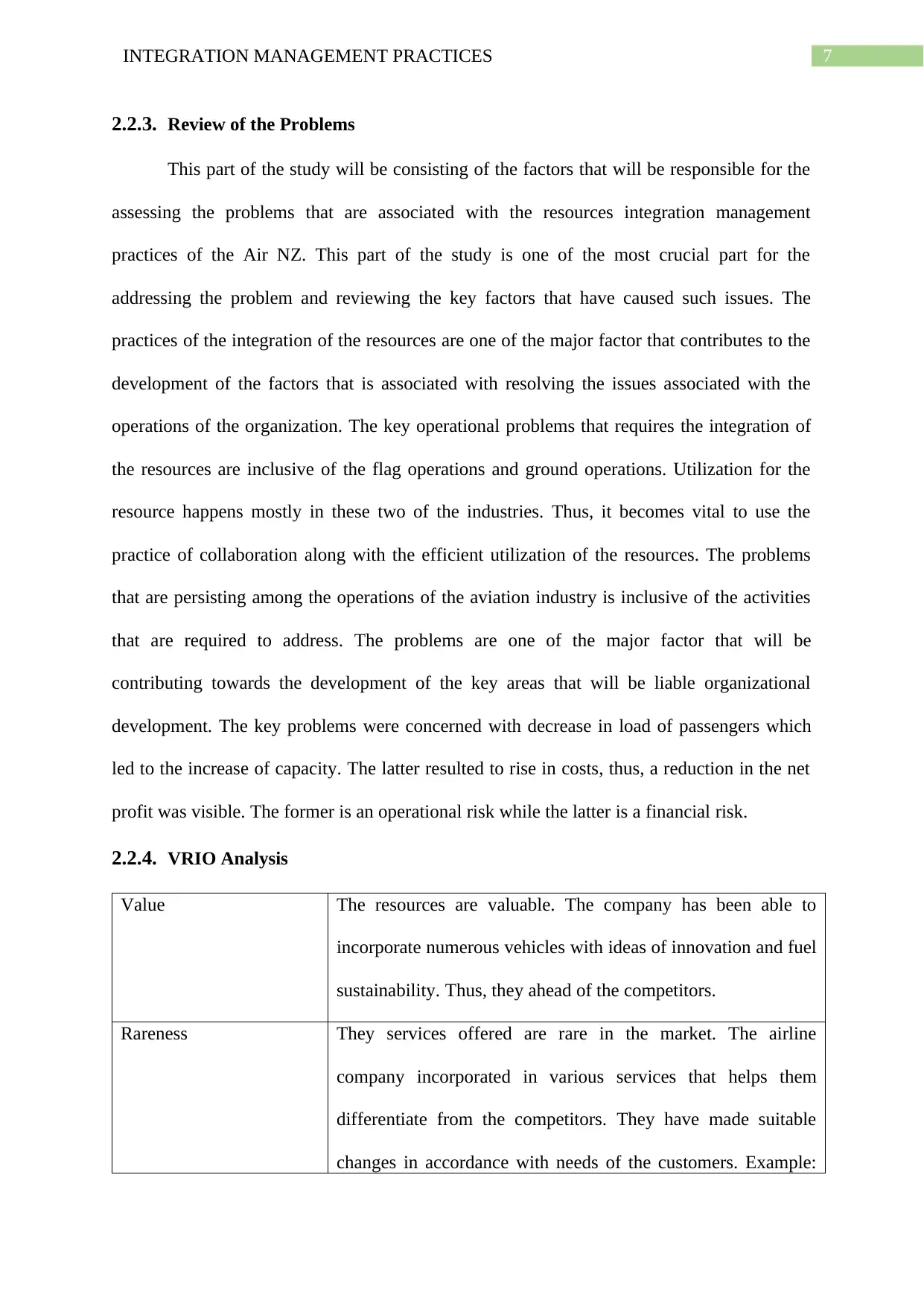
7INTEGRATION MANAGEMENT PRACTICES
2.2.3. Review of the Problems
This part of the study will be consisting of the factors that will be responsible for the
assessing the problems that are associated with the resources integration management
practices of the Air NZ. This part of the study is one of the most crucial part for the
addressing the problem and reviewing the key factors that have caused such issues. The
practices of the integration of the resources are one of the major factor that contributes to the
development of the factors that is associated with resolving the issues associated with the
operations of the organization. The key operational problems that requires the integration of
the resources are inclusive of the flag operations and ground operations. Utilization for the
resource happens mostly in these two of the industries. Thus, it becomes vital to use the
practice of collaboration along with the efficient utilization of the resources. The problems
that are persisting among the operations of the aviation industry is inclusive of the activities
that are required to address. The problems are one of the major factor that will be
contributing towards the development of the key areas that will be liable organizational
development. The key problems were concerned with decrease in load of passengers which
led to the increase of capacity. The latter resulted to rise in costs, thus, a reduction in the net
profit was visible. The former is an operational risk while the latter is a financial risk.
2.2.4. VRIO Analysis
Value The resources are valuable. The company has been able to
incorporate numerous vehicles with ideas of innovation and fuel
sustainability. Thus, they ahead of the competitors.
Rareness They services offered are rare in the market. The airline
company incorporated in various services that helps them
differentiate from the competitors. They have made suitable
changes in accordance with needs of the customers. Example:
2.2.3. Review of the Problems
This part of the study will be consisting of the factors that will be responsible for the
assessing the problems that are associated with the resources integration management
practices of the Air NZ. This part of the study is one of the most crucial part for the
addressing the problem and reviewing the key factors that have caused such issues. The
practices of the integration of the resources are one of the major factor that contributes to the
development of the factors that is associated with resolving the issues associated with the
operations of the organization. The key operational problems that requires the integration of
the resources are inclusive of the flag operations and ground operations. Utilization for the
resource happens mostly in these two of the industries. Thus, it becomes vital to use the
practice of collaboration along with the efficient utilization of the resources. The problems
that are persisting among the operations of the aviation industry is inclusive of the activities
that are required to address. The problems are one of the major factor that will be
contributing towards the development of the key areas that will be liable organizational
development. The key problems were concerned with decrease in load of passengers which
led to the increase of capacity. The latter resulted to rise in costs, thus, a reduction in the net
profit was visible. The former is an operational risk while the latter is a financial risk.
2.2.4. VRIO Analysis
Value The resources are valuable. The company has been able to
incorporate numerous vehicles with ideas of innovation and fuel
sustainability. Thus, they ahead of the competitors.
Rareness They services offered are rare in the market. The airline
company incorporated in various services that helps them
differentiate from the competitors. They have made suitable
changes in accordance with needs of the customers. Example:
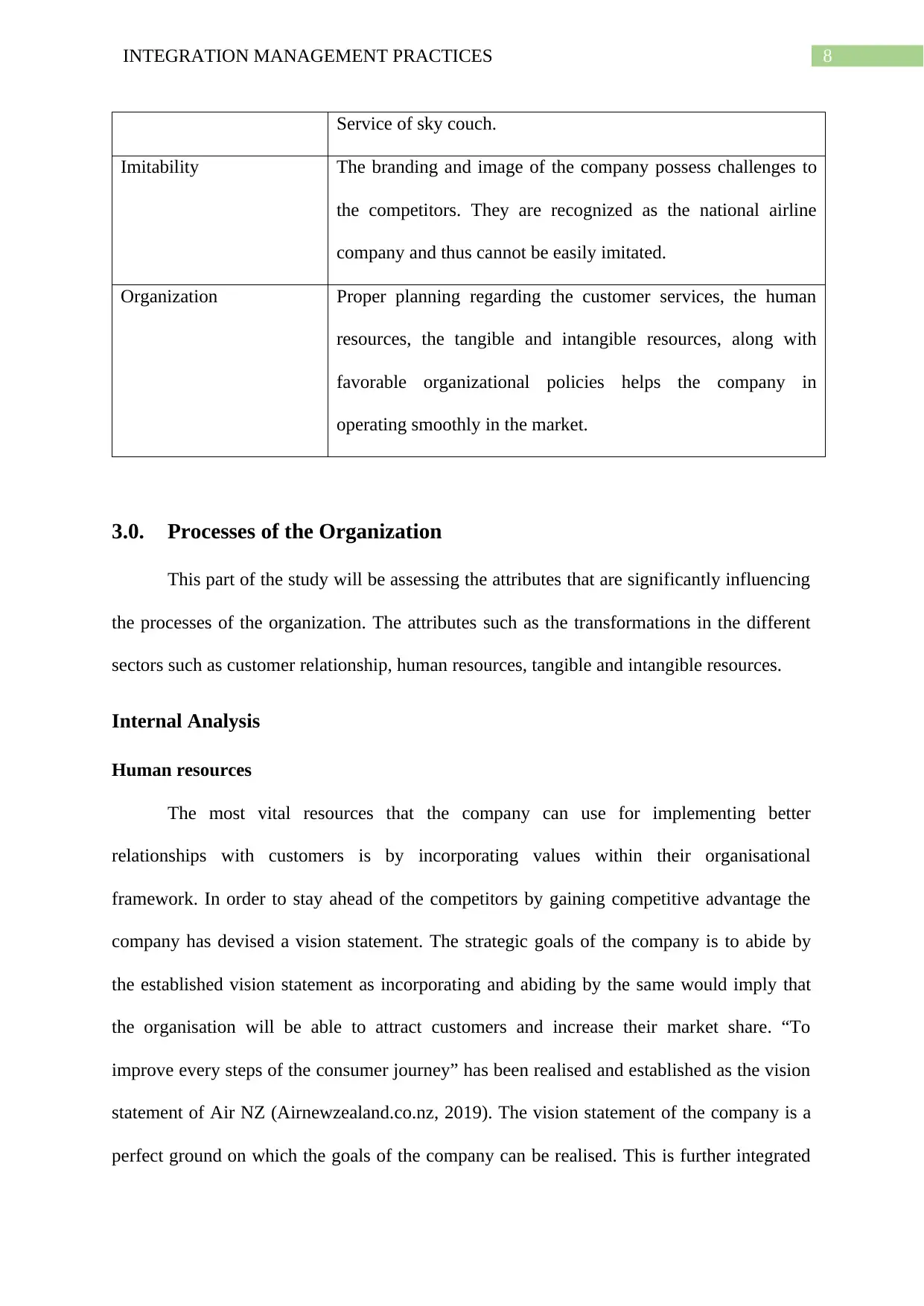
8INTEGRATION MANAGEMENT PRACTICES
Service of sky couch.
Imitability The branding and image of the company possess challenges to
the competitors. They are recognized as the national airline
company and thus cannot be easily imitated.
Organization Proper planning regarding the customer services, the human
resources, the tangible and intangible resources, along with
favorable organizational policies helps the company in
operating smoothly in the market.
3.0. Processes of the Organization
This part of the study will be assessing the attributes that are significantly influencing
the processes of the organization. The attributes such as the transformations in the different
sectors such as customer relationship, human resources, tangible and intangible resources.
Internal Analysis
Human resources
The most vital resources that the company can use for implementing better
relationships with customers is by incorporating values within their organisational
framework. In order to stay ahead of the competitors by gaining competitive advantage the
company has devised a vision statement. The strategic goals of the company is to abide by
the established vision statement as incorporating and abiding by the same would imply that
the organisation will be able to attract customers and increase their market share. “To
improve every steps of the consumer journey” has been realised and established as the vision
statement of Air NZ (Airnewzealand.co.nz, 2019). The vision statement of the company is a
perfect ground on which the goals of the company can be realised. This is further integrated
Service of sky couch.
Imitability The branding and image of the company possess challenges to
the competitors. They are recognized as the national airline
company and thus cannot be easily imitated.
Organization Proper planning regarding the customer services, the human
resources, the tangible and intangible resources, along with
favorable organizational policies helps the company in
operating smoothly in the market.
3.0. Processes of the Organization
This part of the study will be assessing the attributes that are significantly influencing
the processes of the organization. The attributes such as the transformations in the different
sectors such as customer relationship, human resources, tangible and intangible resources.
Internal Analysis
Human resources
The most vital resources that the company can use for implementing better
relationships with customers is by incorporating values within their organisational
framework. In order to stay ahead of the competitors by gaining competitive advantage the
company has devised a vision statement. The strategic goals of the company is to abide by
the established vision statement as incorporating and abiding by the same would imply that
the organisation will be able to attract customers and increase their market share. “To
improve every steps of the consumer journey” has been realised and established as the vision
statement of Air NZ (Airnewzealand.co.nz, 2019). The vision statement of the company is a
perfect ground on which the goals of the company can be realised. This is further integrated
⊘ This is a preview!⊘
Do you want full access?
Subscribe today to unlock all pages.

Trusted by 1+ million students worldwide
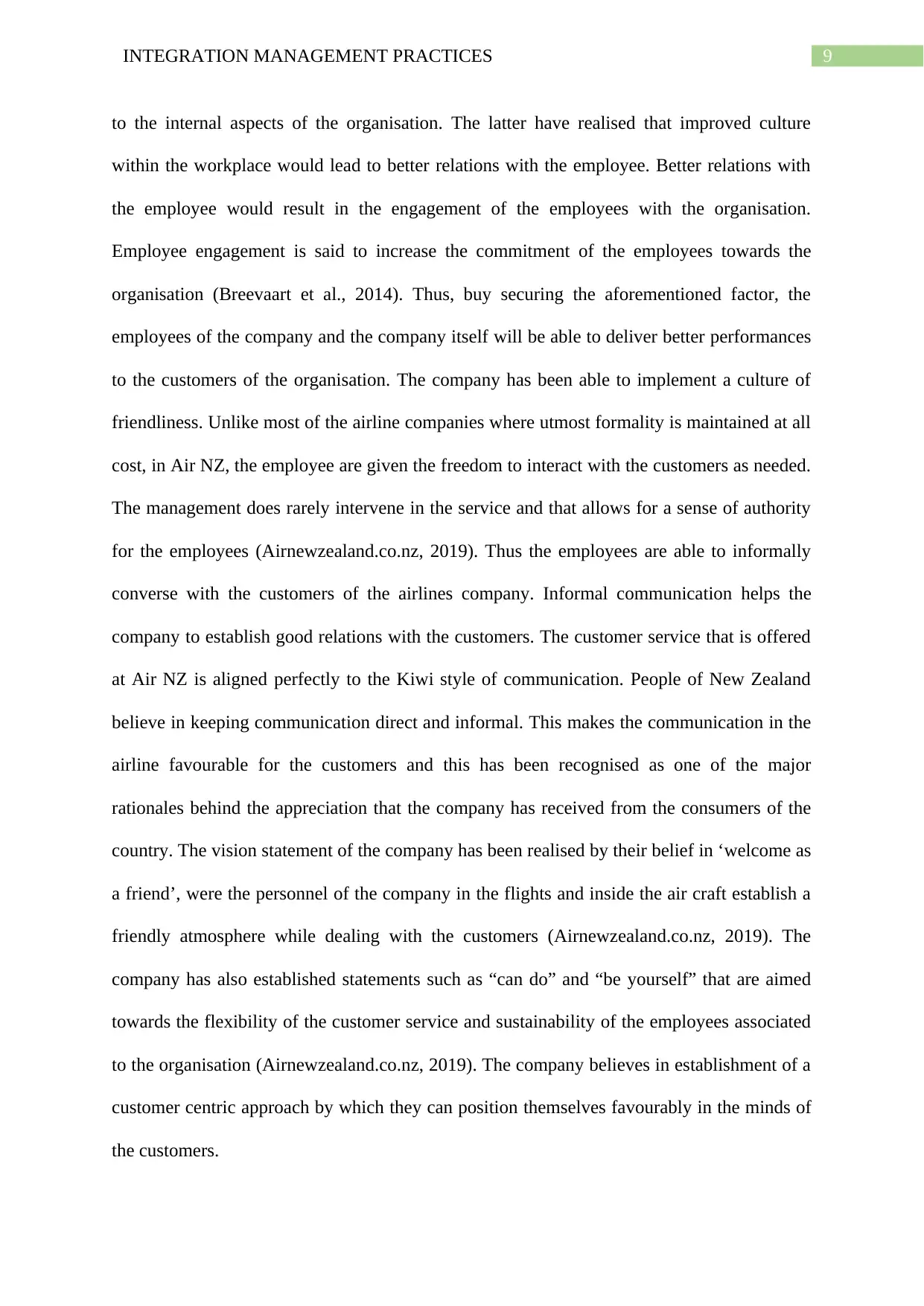
9INTEGRATION MANAGEMENT PRACTICES
to the internal aspects of the organisation. The latter have realised that improved culture
within the workplace would lead to better relations with the employee. Better relations with
the employee would result in the engagement of the employees with the organisation.
Employee engagement is said to increase the commitment of the employees towards the
organisation (Breevaart et al., 2014). Thus, buy securing the aforementioned factor, the
employees of the company and the company itself will be able to deliver better performances
to the customers of the organisation. The company has been able to implement a culture of
friendliness. Unlike most of the airline companies where utmost formality is maintained at all
cost, in Air NZ, the employee are given the freedom to interact with the customers as needed.
The management does rarely intervene in the service and that allows for a sense of authority
for the employees (Airnewzealand.co.nz, 2019). Thus the employees are able to informally
converse with the customers of the airlines company. Informal communication helps the
company to establish good relations with the customers. The customer service that is offered
at Air NZ is aligned perfectly to the Kiwi style of communication. People of New Zealand
believe in keeping communication direct and informal. This makes the communication in the
airline favourable for the customers and this has been recognised as one of the major
rationales behind the appreciation that the company has received from the consumers of the
country. The vision statement of the company has been realised by their belief in ‘welcome as
a friend’, were the personnel of the company in the flights and inside the air craft establish a
friendly atmosphere while dealing with the customers (Airnewzealand.co.nz, 2019). The
company has also established statements such as “can do” and “be yourself” that are aimed
towards the flexibility of the customer service and sustainability of the employees associated
to the organisation (Airnewzealand.co.nz, 2019). The company believes in establishment of a
customer centric approach by which they can position themselves favourably in the minds of
the customers.
to the internal aspects of the organisation. The latter have realised that improved culture
within the workplace would lead to better relations with the employee. Better relations with
the employee would result in the engagement of the employees with the organisation.
Employee engagement is said to increase the commitment of the employees towards the
organisation (Breevaart et al., 2014). Thus, buy securing the aforementioned factor, the
employees of the company and the company itself will be able to deliver better performances
to the customers of the organisation. The company has been able to implement a culture of
friendliness. Unlike most of the airline companies where utmost formality is maintained at all
cost, in Air NZ, the employee are given the freedom to interact with the customers as needed.
The management does rarely intervene in the service and that allows for a sense of authority
for the employees (Airnewzealand.co.nz, 2019). Thus the employees are able to informally
converse with the customers of the airlines company. Informal communication helps the
company to establish good relations with the customers. The customer service that is offered
at Air NZ is aligned perfectly to the Kiwi style of communication. People of New Zealand
believe in keeping communication direct and informal. This makes the communication in the
airline favourable for the customers and this has been recognised as one of the major
rationales behind the appreciation that the company has received from the consumers of the
country. The vision statement of the company has been realised by their belief in ‘welcome as
a friend’, were the personnel of the company in the flights and inside the air craft establish a
friendly atmosphere while dealing with the customers (Airnewzealand.co.nz, 2019). The
company has also established statements such as “can do” and “be yourself” that are aimed
towards the flexibility of the customer service and sustainability of the employees associated
to the organisation (Airnewzealand.co.nz, 2019). The company believes in establishment of a
customer centric approach by which they can position themselves favourably in the minds of
the customers.
Paraphrase This Document
Need a fresh take? Get an instant paraphrase of this document with our AI Paraphraser
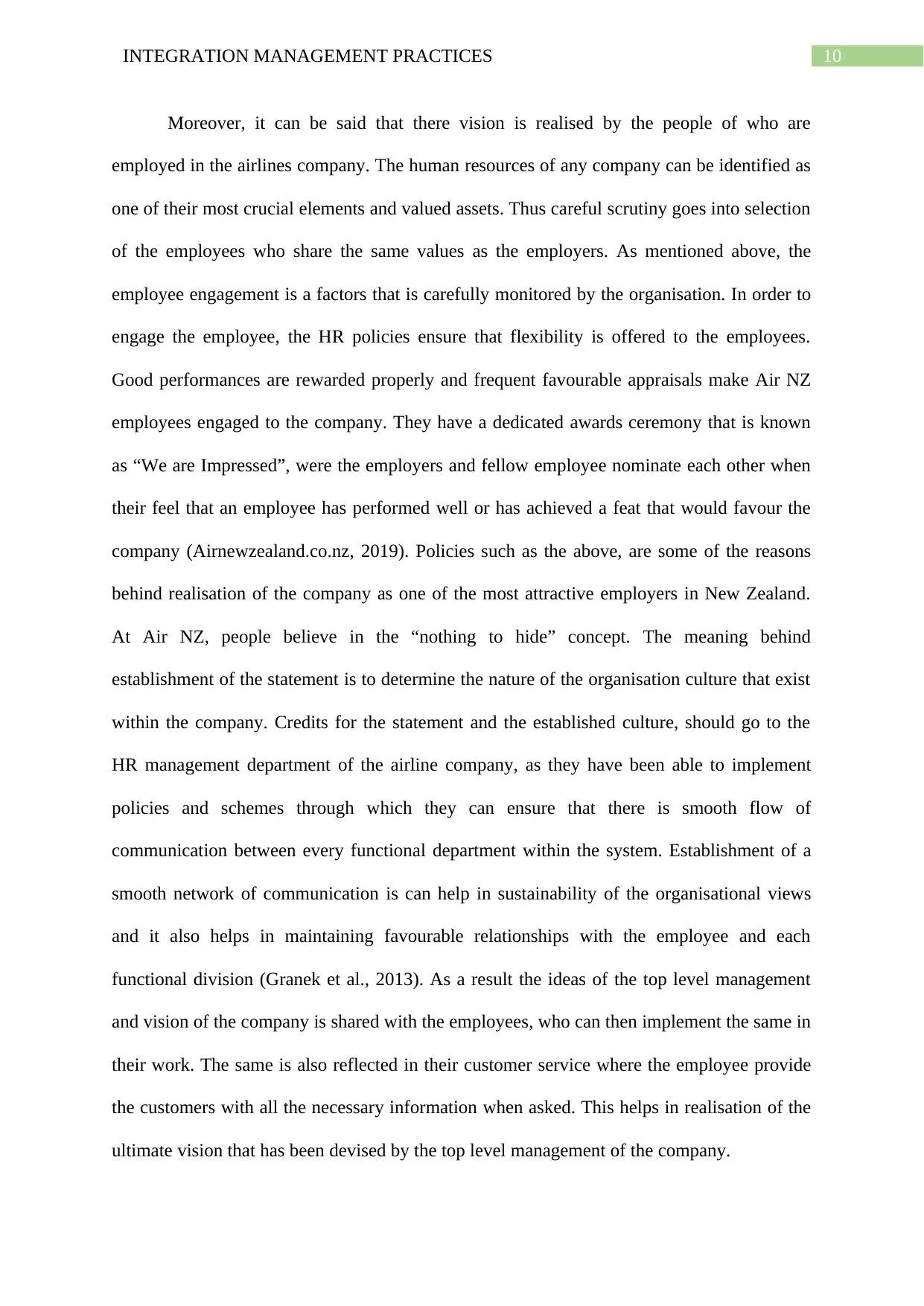
10INTEGRATION MANAGEMENT PRACTICES
Moreover, it can be said that there vision is realised by the people of who are
employed in the airlines company. The human resources of any company can be identified as
one of their most crucial elements and valued assets. Thus careful scrutiny goes into selection
of the employees who share the same values as the employers. As mentioned above, the
employee engagement is a factors that is carefully monitored by the organisation. In order to
engage the employee, the HR policies ensure that flexibility is offered to the employees.
Good performances are rewarded properly and frequent favourable appraisals make Air NZ
employees engaged to the company. They have a dedicated awards ceremony that is known
as “We are Impressed”, were the employers and fellow employee nominate each other when
their feel that an employee has performed well or has achieved a feat that would favour the
company (Airnewzealand.co.nz, 2019). Policies such as the above, are some of the reasons
behind realisation of the company as one of the most attractive employers in New Zealand.
At Air NZ, people believe in the “nothing to hide” concept. The meaning behind
establishment of the statement is to determine the nature of the organisation culture that exist
within the company. Credits for the statement and the established culture, should go to the
HR management department of the airline company, as they have been able to implement
policies and schemes through which they can ensure that there is smooth flow of
communication between every functional department within the system. Establishment of a
smooth network of communication is can help in sustainability of the organisational views
and it also helps in maintaining favourable relationships with the employee and each
functional division (Granek et al., 2013). As a result the ideas of the top level management
and vision of the company is shared with the employees, who can then implement the same in
their work. The same is also reflected in their customer service where the employee provide
the customers with all the necessary information when asked. This helps in realisation of the
ultimate vision that has been devised by the top level management of the company.
Moreover, it can be said that there vision is realised by the people of who are
employed in the airlines company. The human resources of any company can be identified as
one of their most crucial elements and valued assets. Thus careful scrutiny goes into selection
of the employees who share the same values as the employers. As mentioned above, the
employee engagement is a factors that is carefully monitored by the organisation. In order to
engage the employee, the HR policies ensure that flexibility is offered to the employees.
Good performances are rewarded properly and frequent favourable appraisals make Air NZ
employees engaged to the company. They have a dedicated awards ceremony that is known
as “We are Impressed”, were the employers and fellow employee nominate each other when
their feel that an employee has performed well or has achieved a feat that would favour the
company (Airnewzealand.co.nz, 2019). Policies such as the above, are some of the reasons
behind realisation of the company as one of the most attractive employers in New Zealand.
At Air NZ, people believe in the “nothing to hide” concept. The meaning behind
establishment of the statement is to determine the nature of the organisation culture that exist
within the company. Credits for the statement and the established culture, should go to the
HR management department of the airline company, as they have been able to implement
policies and schemes through which they can ensure that there is smooth flow of
communication between every functional department within the system. Establishment of a
smooth network of communication is can help in sustainability of the organisational views
and it also helps in maintaining favourable relationships with the employee and each
functional division (Granek et al., 2013). As a result the ideas of the top level management
and vision of the company is shared with the employees, who can then implement the same in
their work. The same is also reflected in their customer service where the employee provide
the customers with all the necessary information when asked. This helps in realisation of the
ultimate vision that has been devised by the top level management of the company.
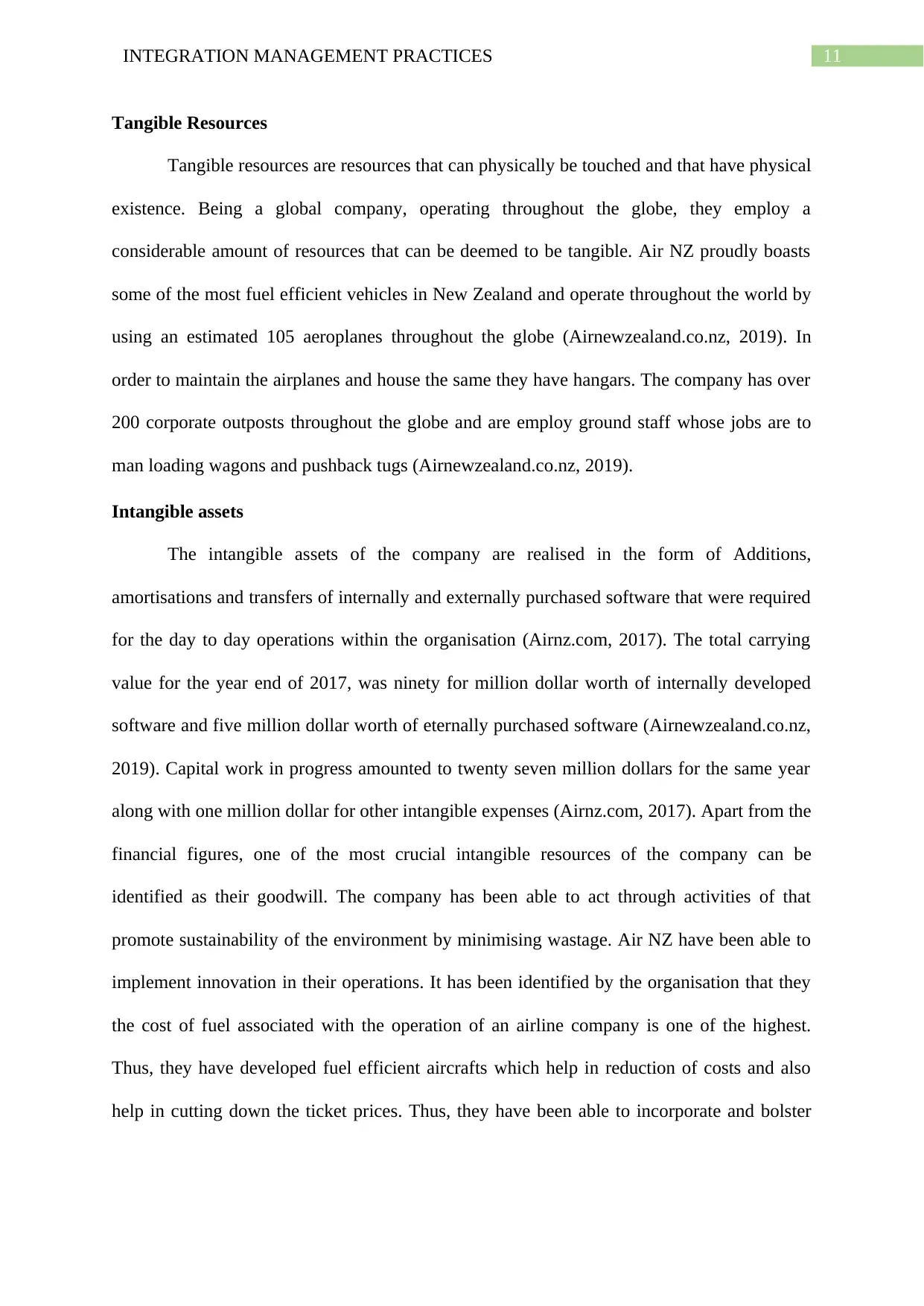
11INTEGRATION MANAGEMENT PRACTICES
Tangible Resources
Tangible resources are resources that can physically be touched and that have physical
existence. Being a global company, operating throughout the globe, they employ a
considerable amount of resources that can be deemed to be tangible. Air NZ proudly boasts
some of the most fuel efficient vehicles in New Zealand and operate throughout the world by
using an estimated 105 aeroplanes throughout the globe (Airnewzealand.co.nz, 2019). In
order to maintain the airplanes and house the same they have hangars. The company has over
200 corporate outposts throughout the globe and are employ ground staff whose jobs are to
man loading wagons and pushback tugs (Airnewzealand.co.nz, 2019).
Intangible assets
The intangible assets of the company are realised in the form of Additions,
amortisations and transfers of internally and externally purchased software that were required
for the day to day operations within the organisation (Airnz.com, 2017). The total carrying
value for the year end of 2017, was ninety for million dollar worth of internally developed
software and five million dollar worth of eternally purchased software (Airnewzealand.co.nz,
2019). Capital work in progress amounted to twenty seven million dollars for the same year
along with one million dollar for other intangible expenses (Airnz.com, 2017). Apart from the
financial figures, one of the most crucial intangible resources of the company can be
identified as their goodwill. The company has been able to act through activities of that
promote sustainability of the environment by minimising wastage. Air NZ have been able to
implement innovation in their operations. It has been identified by the organisation that they
the cost of fuel associated with the operation of an airline company is one of the highest.
Thus, they have developed fuel efficient aircrafts which help in reduction of costs and also
help in cutting down the ticket prices. Thus, they have been able to incorporate and bolster
Tangible Resources
Tangible resources are resources that can physically be touched and that have physical
existence. Being a global company, operating throughout the globe, they employ a
considerable amount of resources that can be deemed to be tangible. Air NZ proudly boasts
some of the most fuel efficient vehicles in New Zealand and operate throughout the world by
using an estimated 105 aeroplanes throughout the globe (Airnewzealand.co.nz, 2019). In
order to maintain the airplanes and house the same they have hangars. The company has over
200 corporate outposts throughout the globe and are employ ground staff whose jobs are to
man loading wagons and pushback tugs (Airnewzealand.co.nz, 2019).
Intangible assets
The intangible assets of the company are realised in the form of Additions,
amortisations and transfers of internally and externally purchased software that were required
for the day to day operations within the organisation (Airnz.com, 2017). The total carrying
value for the year end of 2017, was ninety for million dollar worth of internally developed
software and five million dollar worth of eternally purchased software (Airnewzealand.co.nz,
2019). Capital work in progress amounted to twenty seven million dollars for the same year
along with one million dollar for other intangible expenses (Airnz.com, 2017). Apart from the
financial figures, one of the most crucial intangible resources of the company can be
identified as their goodwill. The company has been able to act through activities of that
promote sustainability of the environment by minimising wastage. Air NZ have been able to
implement innovation in their operations. It has been identified by the organisation that they
the cost of fuel associated with the operation of an airline company is one of the highest.
Thus, they have developed fuel efficient aircrafts which help in reduction of costs and also
help in cutting down the ticket prices. Thus, they have been able to incorporate and bolster
⊘ This is a preview!⊘
Do you want full access?
Subscribe today to unlock all pages.

Trusted by 1+ million students worldwide
1 out of 30
Related Documents
Your All-in-One AI-Powered Toolkit for Academic Success.
+13062052269
info@desklib.com
Available 24*7 on WhatsApp / Email
![[object Object]](/_next/static/media/star-bottom.7253800d.svg)
Unlock your academic potential
Copyright © 2020–2025 A2Z Services. All Rights Reserved. Developed and managed by ZUCOL.





